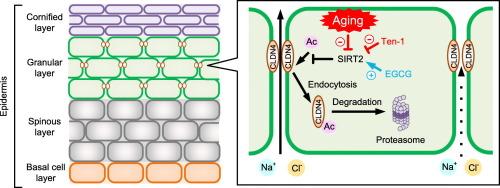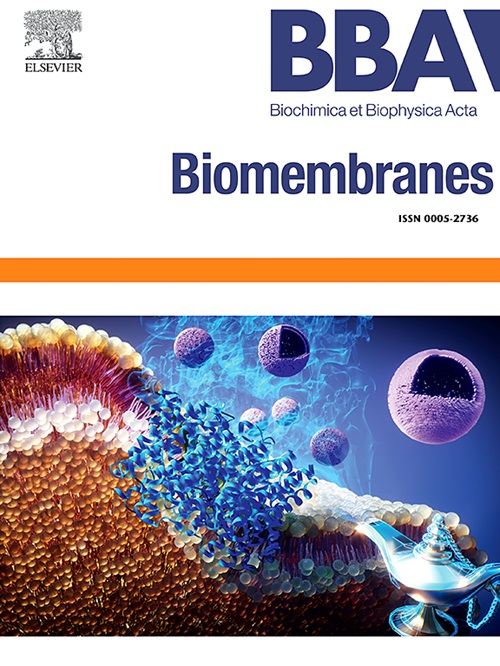没食子儿茶素没食子酸酯对sirtuin抑制剂依赖性的角化细胞claudin-4表达降低和细胞旁屏障特性的拯救作用
IF 2.5
3区 生物学
Q3 BIOCHEMISTRY & MOLECULAR BIOLOGY
引用次数: 0
摘要
皮肤颗粒层的屏障功能主要由紧密连接成分CLDN1 (CLDN1)和CLDN4维持。我们最近发现,抗衰老分子sirtuin-2 (SIRT2)的活性随着角质形成细胞的衰老而降低,导致CLDN4表达和细胞旁屏障功能的衰减。SIRT2可能是增强老年人皮肤屏障功能的新靶点。体外SIRT2活性分析表明,表没食子儿茶素没食子酸酯(EGCG)和绿茶提取物(GT)具有有效的SIRT2激活能力。Tenovin-1 (Ten-1)是一种sirtuin-1/2抑制剂,可降低EGCG和GT拯救的人角化细胞来源的HaCaT细胞中SIRT2的活性。Ten-1可降低EGCG拯救的CLDN4的蛋白水平,而CLDN1的表达不受Ten-1和EGCG的影响。10 -1降低了CLDN4的紧密连接定位、经上皮电阻和细胞旁对FD4(一种荧光细胞旁通量标记物)的通透性,这些被EGCG拯救。10 -1增加了CLDN4的乙酰化水平,EGCG抑制了CLDN4的乙酰化,但不影响SIRT2的底物NAD+含量。野生型和K191A突变体的蛋白水平下降了10 -1,而K196A突变体的蛋白水平没有下降。此外,10 -1增加了WT和K191A突变体的乙酰化水平。我们认为,10 -1降低CLDN4和EGCG的K196乙酰化介导的CLDN4表达,有助于保护角质形成细胞免受衰老诱导的细胞旁屏障功能障碍。本文章由计算机程序翻译,如有差异,请以英文原文为准。

Rescue of sirtuin inhibitor-dependent decrease in claudin-4 expression and paracellular barrier property in keratinocytes by epigallocatechin gallate
The barrier function of granular layer in the skin is mainly sustained by claudin-1 (CLDN1) and CLDN4, tight junctional components. We recently found that the activity of sirtuin-2 (SIRT2), an anti-aging molecule, is decreased with aging in keratinocytes, leading to the attenuation of CLDN4 expression and paracellular barrier function. SIRT2 may be a novel target for enhancing skin barrier function in elderly people. In vitro SIRT2 activity assay showed that epigallocatechin gallate (EGCG) and green tea extract (GT) have a potent ability to activate SIRT2. Tenovin-1 (Ten-1), a sirtuin-1/2 inhibitor, decreased the SIRT2 activity in human keratinocyte-derived HaCaT cells, which was rescued by EGCG and GT. Ten-1 decreased the protein level of CLDN4, which was rescued by EGCG, whereas CLDN1 expression was changed by neither Ten-1 nor EGCG. Ten-1 decreased the tight junctional localization of CLDN4, transepithelial electrical resistance, and paracellular permeability to FD4, a fluorescence paracellular flux marker, which were rescued by EGCG. Ten-1 increased the acetylation level of CLDN4, which was inhibited by EGCG without affecting NAD+ content, a substrate for SIRT2. The protein levels of wild-type and K191A mutant were decreased by Ten-1, whereas that of K196A was not. Furthermore, Ten-1 increased the acetylation levels of WT and K191A mutant. We suggest that Ten-1 decreases CLDN4 expression mediated by the acetylation of K196 of CLDN4 and EGCG is useful to protect from aging-induced dysfunction of paracellular barrier in the keratinocytes.
求助全文
通过发布文献求助,成功后即可免费获取论文全文。
去求助
来源期刊

Biochimica et biophysica acta. Biomembranes
生物-生化与分子生物学
CiteScore
8.20
自引率
5.90%
发文量
175
审稿时长
2.3 months
期刊介绍:
BBA Biomembranes has its main focus on membrane structure, function and biomolecular organization, membrane proteins, receptors, channels and anchors, fluidity and composition, model membranes and liposomes, membrane surface studies and ligand interactions, transport studies, and membrane dynamics.
 求助内容:
求助内容: 应助结果提醒方式:
应助结果提醒方式:


